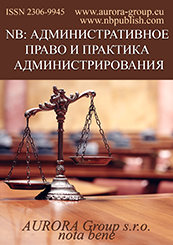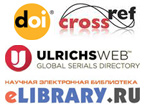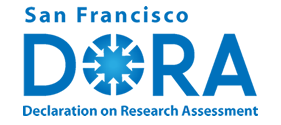Administrative legal regimes and local self-government
Reference:
Golubeva, T.M. (2025). Special regimes of state control (supervision): legal regulation. NB: Administrative Law and Administration Practice, 1, 114. https://doi.org/10.7256/2306-9945.2025.1.73236
Abstract:
The current stage of reforming control (supervisory) activities is associated with increasing the efficiency and effectiveness of state control (supervision). This goal is achieved through the application of the necessary and sufficient regime of state control (supervision). According to the author, depending on the conditions of implementation, the state control (supervision) regimes are divided into general and special ones. The article discusses such special regimes of state control (supervision) such as monitoring, constant state control (supervision), as well as a constant raid. In addition, the author suggests that temporary regimes should be attributed to special state control (supervision) regimes: a moratorium on inspections, an experiment on the use of remote control in the field of industrial safety, as well as the implementation of state control (supervision) during the operation of experimental legal regimes. The analysis of the current legislation on the regulation of state control (supervision) regimes is carried out. The methodological basis was provided by general scientific (analysis, synthesis) and special (formal-legal, comparative-legal) methods of cognition. As a result of the conducted research in the field of state control (supervision) through the application of the necessary and sufficient regime of state control (supervision), the following conclusions can be drawn. Firstly, special state control (supervision) regimes are an effective tool for ensuring safety at high-risk facilities (permanent state control (supervision) regime). Secondly, the legal regulation of special state control (supervision) regimes requires improvement through the adoption of additional regulatory acts. Thirdly, it is determined that the implementation of special state control (supervision) regimes, including temporary ones, reduces administrative pressure on business entities. In addition, the author comes to the conclusion that it is necessary to legislate temporary regimes of state control (supervision). as special regimes of state control (supervision).
Keywords:
experimental legal regimes, constant raid, permanent state control, monitoring, moratorium on inspections, State control regime, special modes, State supervision, temporary control modes, State control
Administrative and municipal law: business, economy, finance
Reference:
Chereshneva, I.A. (2025). On criteria for differentiation of the legal regime of Closed Administrative-Territorial Formations. NB: Administrative Law and Administration Practice, 1, 1523. https://doi.org/10.7256/2306-9945.2025.1.73669
Abstract:
Territories of advanced development (hereinafter TAD) are one of the effective tools for stimulating the development of closed administrative-territorial formations (hereinafter CATF). Due to their specific nature-determined by the importance of national defense and state security, technological sovereignty of the Russian Federation, and the development of high-tech industries the arsenal of traditional economic instruments for stimulating socio-economic development is significantly limited. This raises the issue of the need for differentiation of the legal regime of Closed Administrative-Territorial Formations. The objective of the study is to define the differentiation. Based on the research findings, the author concludes that it is necessary to develop a model for differentiating the legal regime of CATF as a type of territory with a special protective regime of entrepreneurial activities. The framework of this model is defined by the following criteria: 1) the departmental affiliation of CATF: the Ministry of Defense of the Russian Federation; the State Atomic Energy Corporation "Rosatom"; the State Space Corporation "Roscosmos"; 2) the nature of the activities carried out by organizations and (or) facilities located within CATF: Closed-type CATF and Open-type CATF. The latter provide greater opportunities for the use of Private Law instruments and active participation of business entities; therefore, this type includes CATF where TAD have been established; 3) the role of the government agency in the socio-economic development of CATF: direct or indirect participation; 4) the government agency interest in the socio-economic development of CATF: strong, medium, weak.
Keywords:
military-industrial complex, preference, public-private partnership, special entrepreneurial regime, state corporation, TAD, the legal regime of entrepreneurship, territories of advanced development, closed administrative-territorial formation, CATF
Theory and science of administrative and municipal law
Reference:
Kostin, S.G. (2025). Police discretion in the context of the digital transformation of public administration. NB: Administrative Law and Administration Practice, 1, 2438. https://doi.org/10.7256/2306-9945.2025.1.72163
Abstract:
The problem of police discretion is one of the key issues in the modern science of administrative law and public administration practice. The relevance of the topic is due to the need to find an optimal balance between giving police officers a certain degree of freedom in decision-making and ensuring the legality of their actions. In the context of the digital transformation of public administration, issues of modernization of mechanisms for the implementation of discretionary powers are of particular importance. The subject of the study is the discretionary powers of police officers in the course of administrative activities. The purpose of the study is to analyze the factors influencing the decision-making process of police officers, to determine the limits of police discretion, as well as to formulate proposals for the modernization of mechanisms for the implementation of discretionary powers in the context of the digital transformation of public administration. During the research, the dialectical method of scientific cognition was used, as well as a system of general scientific and private scientific methods based on it. Of the general scientific methods used: logical method, system-structural method. Of the private scientific methods used: the formal legal method and the method of comparative jurisprudence. Based on the positive foreign experience, the possibilities of adapting successful practices of regulating discretionary powers were considered. In the article, the author formulated the most significant directions for the introduction and development of technologies of the public administration system, as well as the possibilities provided by them for use in law enforcement activities. The analysis of theoretical aspects and factors influencing the decision-making process of police officers in the context of digitalization of public administration allowed the author to propose directions for the modernization of mechanisms for the implementation of discretionary powers.
Keywords:
digital technologies, administrative procedures, artificial intelligence, digital environment, administrative activities, police, discretionary powers, public administration, digital transformation, police discretion
Issues of administrative and municipal legal relationship
Reference:
Zolotukhina, M.S. (2025). Information modeling technologies in urban development of Russia and China. NB: Administrative Law and Administration Practice, 1, 3951. https://doi.org/10.7256/2306-9945.2025.1.72836
Abstract:
The subject of the study is a comparative analysis of the implementation of Information modeling technologies (TIM) in urban planning activities in Russia and China. Despite the global trend towards an increase in the introduction of information modeling (IM) technologies in construction, the advantages and difficulties of their application remain insufficiently studied in the context of comparative analysis. Most studies focus on the experiences of individual countries, while cross-national comparative studies are rarely conducted. The methodology of the work is based on the analysis of regulatory documents, government initiatives, as well as on the study of practices and approaches to the implementation of TIM in Russia and China. The paper uses methods of qualitative and quantitative analysis to evaluate the effectiveness of these approaches. The purpose of the study is to identify common features and main differences in approaches to the implementation of TIM in the Russian Federation and China, as well as to identify factors influencing the effectiveness of their application in urban planning. The focus is on studying the practices of both countries, assessing government and organizational support, as well as the impact of building standards and traditions. Based on the results obtained, recommendations have been formulated to improve the processes of TIM implementation in both countries. The scope of the research results includes improving the processes of implementing TIM in urban planning, developing recommendations to improve the efficiency of implementing digital technologies in the construction industry in Russia and China. The results can be useful for government agencies, construction companies, and organizations involved in the design and implementation of construction projects. The scientific novelty of the study is to conduct a cross-national comparative analysis of the introduction of information modeling technologies in urban development in Russia and China. Unlike existing research, the work focuses on a comprehensive assessment of the impact of the regulatory framework, government support and building traditions on the effectiveness of the application of TIM in urban planning. The similarities and differences in the application of TIM in the framework of urban development in the Russian Federation (RF) and the People's Republic of China (PRC) are considered. Both countries are actively implementing digital technologies in the construction industry, supporting this process at the state level. However, differences in the regulatory framework, the level of technical development and professional competence create distinctive conditions for the integration of TIM in each of these countries.
Keywords:
design efficiency, technology integration, sustainable construction, Government support, regulatory framework, digitalization, People's Republic of China, Russian Federation, urban planning, information modeling technologies
Administrative law, municipal law and the issues of education
Reference:
Druzhinin, A.V. (2025). Legal Aspects of Combating Plagiarism in Student's Qualifying Works: Problems and Solutions in Higher Education. NB: Administrative Law and Administration Practice, 1, 5268. https://doi.org/10.7256/2306-9945.2025.1.69110
Abstract:
The article presents a comprehensive analysis of the legal aspects of combating plagiarism in final qualifying works in Russian universities. The norms of federal legislation regulating the organization of the educational process and final certification are examined. The study analyzes the local regulations of universities that establish requirements for the originality of works and plagiarism detection procedures. The powers of universities to identify and suppress plagiarism, including the right to prevent works from being defended and expel students, are disclosed. The rights of students in situations of suspected plagiarism, guarantees of objective assessment, and the possibility of appeal are highlighted. Considerable attention is paid to the technical and methodological problems of checking texts for originality, including the reliability and validity of anti-plagiarism systems, determining the permissible amount of borrowing, and expert evaluation of verification results. The research relies on a comprehensive methodology, including the analysis of legal acts, the study of scientific publications on the problem of plagiarism, and the generalization of the practice of Russian and foreign universities. The work employs methods of legal, comparative, and interdisciplinary analysis, allowing for a comprehensive examination of the problem. The necessity of improving legal regulation at the federal level and in local acts of universities is substantiated. The importance of establishing clear criteria for the originality of works, developing transparent procedures for plagiarism detection, and creating appeal mechanisms to protect students' rights is emphasized. Gaps in the legal regulation of the use of artificial intelligence in writing works and the difficulty of identifying generated texts are revealed. The study of international experience has made it possible to identify best practices that can be adapted to Russian conditions, such as the use of licensed anti-plagiarism systems, the creation of university repositories, and the use of stylometric analysis methods.
Keywords:
Administrative document, Higher education, Law enforcement practice, Law On Education in the Russian Federation, Administrative and legal regulation, Plagiarism check, Non-normative legal act, Inappropriate borrowings, Final qualifying work, Academic ethics
 This work is licensed under a Creative Commons Attribution-NonCommercial 4.0 International License.
This work is licensed under a Creative Commons Attribution-NonCommercial 4.0 International License.









 © 1998 2025 Nota Bene. Publishing Technologies. NB-Media Ltd.
© 1998 2025 Nota Bene. Publishing Technologies. NB-Media Ltd.




